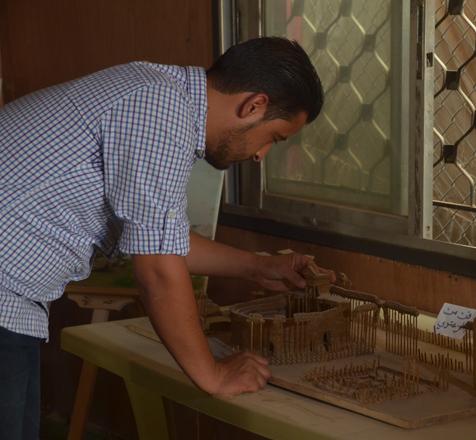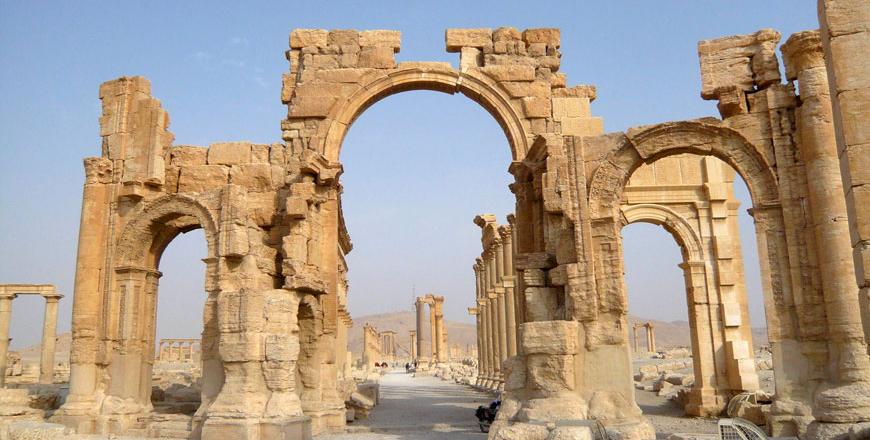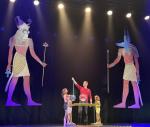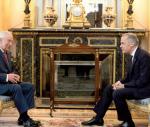You are here
Refugee artists on mission to spread awareness of lost Syrian heritage
By Muath Freij - Sep 29,2015 - Last updated at Sep 29,2015

A Syrian artist works last week on a piece that was on diplay in an exhibition at Zaatari Refugee Camp to shed light on Syria’s heritage (Photo by Muath Freij)
ZAATARI REFUGEE CAMP – Mahmoud Hariri, a young Syrian refugee, reacted to Daesh’s destruction of the ancient city of Palmyra in Syria by creating a piece of art depicting the ancient site. His work was then displayed alongside others at Zaatari, Jordan’s largest refugee camp.
Although Hariri himself did not live in Palmyra when he was in Syria, the significance of the brutal damage caused to a part of his heritage was not lost on him. He engaged in intensive research in order to complete his work.
“I really feel sad about what happened in the Palmyra because it is an important part in the history of Syria,” he told The Jordan Times in a recent interview in the camp.
Hariri’s piece is among many works of art that are on display in a caravan in the camp provided by International Relief and Development (IRD).
The caravan art project, supported by the NGO, features numerous pieces that illustrate Syria’s vast archeological sites and treasures.
IRD’s Assistant Coordinator and Community Engagement Sports and Recreation Officer Abdalrhman Shishani said the project hopes to help both the artists and residents of the camp develop a wide variety of skills. He announced that the works would soon be displayed in Amman.
“The idea for the project germinated in August last year. We worked on several works of art to show Syria’s archeological sites and cultural attractions in order to raise international awareness of Syria’s incredible heritage, as well as of the many consecutive civilisations that rose and fell in our country,” Hariri stated.
Six Syrian artists took part in the exhibition, with pieces also showing sites — like Palmyra — that have either been destroyed or damaged by the current Syrian conflict.
“The IRD supported the project in its entirity and brought us supplies that we can use in our work. We also recycled some items that we needed and could not find in the camp,” he added, alluding to the innovative nature of the artists who have had to come up with inventive ways to access all the necessary materials.
Hariri stated that the project is “important”, not only in spreading awareness of Syria’s cultural heritage but also in educating young displaced Syrians about their homeland.
“Because we have been in the camp for four years and there are children who were born here, they have not seen Syria and its treasures. This exhibition will expose them to their own country and create bonds of attachment to it.”
He said the exhibition is divided into two parts: history and civilisation.
“Civilisation is about the folkloric art and traditions of Syria. We will also depict daily life in the country.”
“We want to go a step further and hold our exhibition outside the camp,” he added. “People who are outside the camp are not all aware of the extent of the ruin.”
Ismail Hariri, a 44-year-old sculptor who contributed to the show had another source of inspiration, but a positive one.
The father of seven said he is currently working on a piece that highlights Jordan’s renowned site Petra.
“This is a gesture of gratitude to Jordan for hosting and helping us,” the Daraa-born man added.
Related Articles
DAMASCUS — Two rare busts rescued from the Daesh terror group in the ancient city of Palmyra and restored in Italy have been returned to Syr
By Maher Al Mounes and Jean-Marc MojonAgence France-PressePALMYRA, Syria — A decade of war has not only destroyed Syria's present and poiso
BEIRUT — A powerful blast in the ruins of Syria's ancient Palmyra raised fears Monday that the Daesh terror group has damaged another of the
















